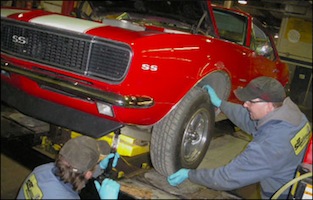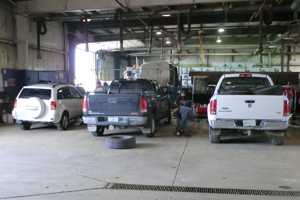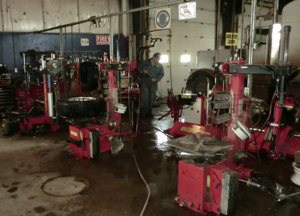Tips
When installing new tires you should replace at least two at the same time to prevent any unwanted wear to tires and vehicles steering, braking or drive train components. Balancing the tires and wheel assembly will help with any unwanted vibrations or uneven wear of the tires. A tire and wheel assembly is balanced to help compensate for both the weight of the tire and wheel after a tire is mounted. A tire and wheel assembly is balanced when one area is heavier or lighter than the rest of the assembly. Improper balance can cause irregular tread wear, vibration and increased stress on the vehicles components, which may cause them to wear prematurely.

When wheels are out of balance you will feel a shimmy or vibration in your vehicle starting around 80 km/h and getting stronger as your speed increases. A vibration in your steering could mean an imbalance in your front tires. A vibration felt in your seat or the rest of the car could mean your rear wheels are out of balance. A vibration or unwanted wear could also come from broken or worn out parts on a vehicle. An unbalanced wheel assembly can cause your tires tread to wear unevenly in patches, also known as "cupping".
Advanced and unusual wear can reduce the ability of tread to grip the road in adverse conditions. Check your tires for uneven wear, looking for high/low areas or unusually smooth areas. You can check your remaining tread depth with either a tread depth gauge or even with a penny. With a tread depth gauge, if is reads 2/32 left of the tread you should have the tires replaced. Using a penny place it into the grooves of the tread, with the queen's head down, if you can see her crown the tires should be replaced.
Properly maintained tires will give you a more comfortable ride and a longer tread life. Maintenance tips:
- clean tires with soap, water and a soft brush or a rag
- check tires frequently for any cuts, snags, punctures, or any other injury
- rotate tires around every 10,000 kms and recheck balance of tires about every second rotation
- check or have someone else recheck the torque of the lug nuts after the first 25 km and make it part of your regular maintenance routine
- check tires for any premature wear or any uneven wear patterns
Alignment generally refers to the adjustment of a vehicle's front and rear suspension parts. Proper alignment ensures that your vehicle handles correctly and will help increase the life and performance of your tires. Wheels become misaligned from hitting potholes, curbs or other road hazards and even worn out steering and suspension parts.
Check your tires air pressure, with a tire gauge at least once a month. A tire can lose 1-2 psi every month and with every five degree drop in temperature. Pressure should be checked when tires are cold, or at standing temperature. Under inflation results in unnecessary tire stress, irregular wear, loss of control and accidents. A tire can loose up to half of its air pressure and not appear to be flat.

Narrow tires are generally better in the rain or snow than wide tires.
Avoid hydroplaning (skim over the surface of the road with little or no traction) by staying out of deep or standing water and by matching speed to conditions. If car hydroplanes, stay off the gas or brake, avoid sudden steering and wait.
Stopping on wet roads can take up to four times the normal distance. If your tread is worn, tires will tend to hydroplane.
Lower air pressure does not improve winter traction (the friction between the tires and the road surface, the amount of grip provided) - you want the tire to bite down to the pavement, not float on the snow.

The government of Canada suggests that winter tires be used during the winter months. If putting on winter tires at least two should be changed but the Canadian government suggests installing four.
If properly cared for, tires can last a long time - on average you should get 60,000-110,000 kms.
When replacing tires, you should never choose a tire that is smaller in size, lower in speed rating or a load capacity lower than the tires that came with the vehicle. When replacing two tires on a front wheel drive vehicle it is recommended that the new tires be put on the rear of the vehicle to help with the control of the vehicle. On rear wheel drive vehicles it's recommended that the new tires be installed on the front.
Regular rotation extends the life to your tires, saving you time and money in the long run. For rotation, each tire and wheel assembly is removed from the vehicle and moved to a difference position. This ensures that all of the tires wear evenly and last longer. Wheels should be torque checked after the first 25 kms after installation and made part of your regular maintenance routine.
